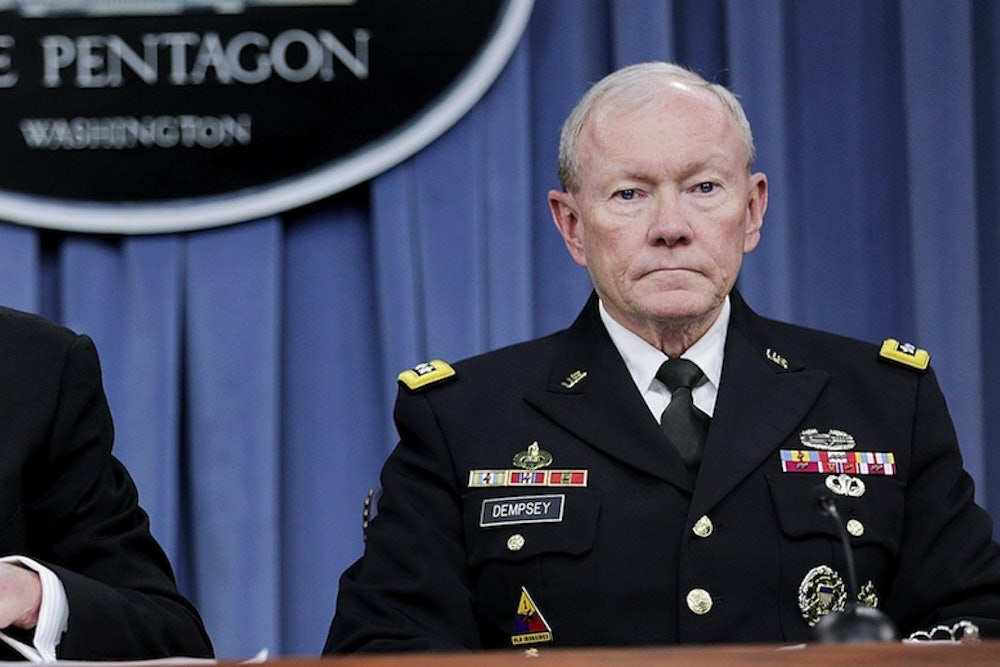During Friday’s Pentagon press briefing, General Martin Dempsey, chairman of the Joint Chiefs of Staff, said that the 2015 defense budget no longer reflects the military’s needs. “[We] said it could accomplish the nation’s security needs with certain assumptions. One of them was that the number of commitments would either level off or come down,” he said.
That assumption was wrong. In its escalating war against the Islamic State (IS), the U.S. now has military personnel training Iraqi, Kurdish, and Syrian forces and has bombed nearly 200 enemy targets in the past month. Due to the vaguely defined scope of the conflict—President Barack Obama has vowed not to deploy U.S. combat troops—it has been hard to put a dollar amount on the operation. But a Center for Strategic and Budgetary Assessments (CSBA) report released Monday estimates that the U.S. has already spent between $780-$930 million in Iraq and Syria. In just the past month, the cost was $250-$400 million, or $9-$14 million per day.
Defense Secretary Chuck Hagel, who spoke alongside Dempsey at Friday’s briefing, gave an estimated daily cost of $7-$10 million dollars, significantly lower than the CSBA numbers. “We’re going to require additional funding from Congress as we go forward,” said Hagel. Currently, the military is relying on money from the budget for Overseas Contingency Operations, often referred to as war funding. The proposed FY 2015 defense budget allocates $58.6 billion for war funding—but 91 percent of that is set aside for residual operations in Afghanistan.
Because Obama has yet outline any long-term plan for U.S. efforts in Iraq and Syria, CSBA’s long-term cost estimates are based on likely hypothetical levels of warfare. If the U.S. draws down airstrikes to approximately 100 targets a month (there have been 200 targets this month, but air campaigns usually peak early because targets learn to hide) and caps U.S. personnel at 2,000, the cost is estimated to be between $2.4 and $3.8 billion a year. But if the administration follows recommendations to deploy 25,000 ground forces and raises the number of air strikes to 200 a month, it will be closer to $13-$22 billion annually.
To put this in perspective, the U.S. spent approximately $1.1 billion in total direct expenditures in the 2011 NATO-led intervention in Libya—not including a significant level of covert funding related to the operation. U.S. efforts in Iraq and Syria are already set to far surpass the Libya operation, both in terms of cost and time commitment.
The CSBA report notes the cost of the current conflict pales in comparison to the wars in Iraq and Afghanistan. Iraq War spending peaked in 2008 at $164 billion a year. In 2011, the most expensive year of the war in Afghanistan, the U.S. spent $122 billion. But it is unlikely that the current war against IS has reached its peak burn rate, and the conflicts in Afghanistan and Iraq did not begin as astronomically expensive operations. The U.S. spent $21 billion during the first 15 months in Afghanistan, and $15 billion in the first year of the Iraq War.
While Congress is being asked to fund a new war effort, the Pentagon’s budget is set to take an automatic yearly spending cut in an effort to reduce defense spending by $1 trillion over the next decade. This is part of the infamous sequester—or austere budget cuts across all departments of government, which began in 2013 after Congress failed to devise an alternative plan to curb the national deficit.
There is now bipartisan agreement that the sequester was a bad idea. Senators John McCain, Bill Nelson, and Lindsey Graham have all called for the repeal of automatic defense spending cuts.
